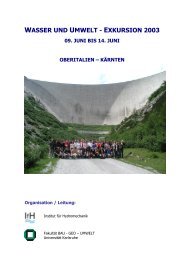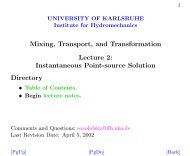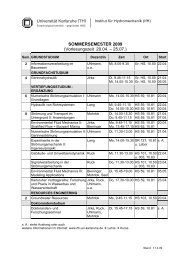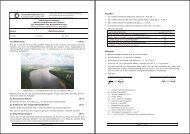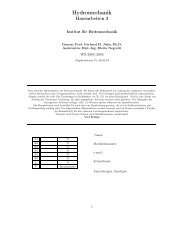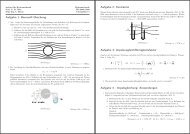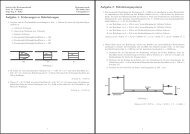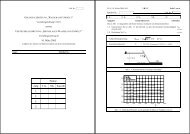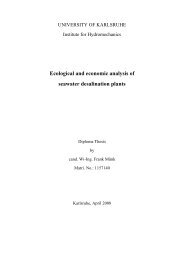user's manual for corhyd: an internal diffuser hydraulics model - IfH
user's manual for corhyd: an internal diffuser hydraulics model - IfH
user's manual for corhyd: an internal diffuser hydraulics model - IfH
You also want an ePaper? Increase the reach of your titles
YUMPU automatically turns print PDFs into web optimized ePapers that Google loves.
only 10 m (4 ports) where velocities are lower. Negative consequences of the taper is a higher<br />
head (5 % increase of the relative head) <strong>an</strong>d a more distorted discharge distribution.<br />
Fig. 31: Flow characteristics <strong>for</strong> tapered <strong>diffuser</strong>. Left: reduced <strong>diffuser</strong> diameter of 1.4 m <strong>for</strong> end part,<br />
right: basecase, both <strong>for</strong> design flow Q d = 8 m³/s. Top-down: Individual riser flow distribution<br />
along <strong>diffuser</strong>, riser flow deviation from me<strong>an</strong>, losses in port/riser configurations (line), port<br />
<strong>an</strong>d jet discharge velocities <strong>an</strong>d <strong>diffuser</strong> pipe velocities, port <strong>an</strong>d <strong>diffuser</strong> diameter (lines)<br />
Constructional alternatives<br />
The piling of the <strong>diffuser</strong> pipe caused problems due to broken piles <strong>an</strong>d there<strong>for</strong>e leakage at<br />
<strong>diffuser</strong> pipe joints. State of the art constructional design alternatives would try to avoid these<br />
problems by using a HDPE pipe with concrete weights fixing the <strong>diffuser</strong> on the ground. The<br />
<strong>internal</strong> <strong>hydraulics</strong> would be affected by only by minor differences in roughness.<br />
a ) Covered <strong>diffuser</strong> or in trench - short risers<br />
If wave <strong>for</strong>cing, sediment tr<strong>an</strong>sport or navigation <strong>an</strong>d fishing activities are a major problem<br />
<strong>for</strong> the <strong>diffuser</strong> pipe, it also c<strong>an</strong> be covered (Fig. 32) or laid in a trench (Fig. 33). In both cases<br />
short risers have to be used to connect the buried pipe with the ambient water. The riser pipes<br />
with the two attached ports are causing additional losses <strong>an</strong>d there<strong>for</strong>e distort the discharge<br />
profile, especially due to the previous tapering causing different riser/<strong>diffuser</strong> ratios <strong>an</strong>d<br />
there<strong>for</strong>e non-uni<strong>for</strong>m distributions (Fig. 34). Increasing the riser diameter in the tapered<br />
<strong>diffuser</strong> end part allows to equilibrate these additional ch<strong>an</strong>ges, because the additional<br />
separation losses depend on the diameter ratio between <strong>diffuser</strong> pipe <strong>an</strong>d riser pipe. The risers<br />
there<strong>for</strong>e have a diameter of 0.3 m at the end part <strong>an</strong>d of 0.2 at the near-shore part of the<br />
<strong>diffuser</strong>. In this case the only ch<strong>an</strong>ge is a little increase in total head of about 4 % compared<br />
to the tapered <strong>diffuser</strong> with no risers <strong>an</strong>d 10 % compared to the basecase (Fig. 34).<br />
Institut für Hydromech<strong>an</strong>ik, Universität Karlsruhe 59



